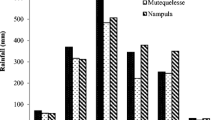Summary
Rhizobial inoculation trials were conducted in an acid heavy clay soil in Mekong Delta, Viet Nam, using peat based inoculants produced locally and the commercial granular product of Nitragin CCo., Wisconsin, USA. The pH of these soils ranged from 4.5 to 5.1. Two soybean cultivars, MTD6 and MTD10, were tested as host plants. There were no significant differences between locally made inoculant treated plants and the uninoculated controls in both cultivars. But, the Nitragin inoculation improved all plant characteristics examined in both cultivars. Grain yields of Nitragin inoculated plants of cultivar MTD6 and cultivar MTD10 were 6.5 and 5.5 times as much as those of the controls; protein content of grain increased 11 and 16 percent, respectively. Well nodulated plants had shorter life cycles, flowering durations, and days to flowering. The Rhizobium symbiosis resulted in an additional 153 kg grain-N/ha. These studies show that a surface coated commercial multistrain inoculant can be used to successfully grow soybeans in the acid, heavy clay soils of the Mekong Delta.
Similar content being viewed by others
References
Freire J R 1977 Inoculation of soybeans. 335–379.In Exploiting theLegume-Rhizobium Symbiosis in tropical Agriculture. Eds. J M Vincent, A S Whitney and J Bose. Proceedings of a workshop held at Kahului, Maui, Hawaii, August 23–28, 1976.
Dung Tran nhan 1980 Effects of plant population density and plant spacing on grain yields of soybean cultivar DH4. Agro. Eng. Thesis, Univ. of Can Tho.
Hardy R W F, Burns R C, Herbert R R, Holsten R D and Jackson E R 1971 Biological nitrogen fixation: A key to world protein. Plant and Soil, special vol. 1971, 561–590.
Moormann F R 1961 The soils of the Republic of Viet Nam. Directorate of Studies and Research in Agronomy, Forestry and animal Husbandry, Ministry of Agriculture, Saigon.
Munns D N 1977 Soil acidity and related factors. 211–236.In Exploiting the Legume-Rhizobiun symbiosis in tropical Agriculture. Eds. J M Vincent, A S Whitney and J Bose. Proceedings of a workshop held at Kahului, Maui, Hawaii, August 23–28, 1976.
Rai R and Singh S N 1979 Interaction between chickpeas (Cica arietinum Linn.) genotypes and strains of Rhizobium sp. J. Agric. Sci. Camb. 92, 437–441.
Tin Chu Huu 1980Rhizobium japonicum inoculation onGlycine max in Viet Nam. Soybean Genetics Newsletter. 7, 97–100.
Weber D F, Caldwell B E, Sloger C and Vest H G 1971 Some USDA studies on the soybean-Rhizobium symbiosis. Plant and Soil, Spec. Vol. 1971, 293–304.
Author information
Authors and Affiliations
Rights and permissions
About this article
Cite this article
Duong, T.P., Diep, C.N., Khiem, N.T. et al. Rhizobium inoculant for soybean [Glycine max (L.) Merrill] in Mekong Delta. Plant Soil 79, 235–240 (1984). https://doi.org/10.1007/BF02182345
Received:
Revised:
Issue Date:
DOI: https://doi.org/10.1007/BF02182345




